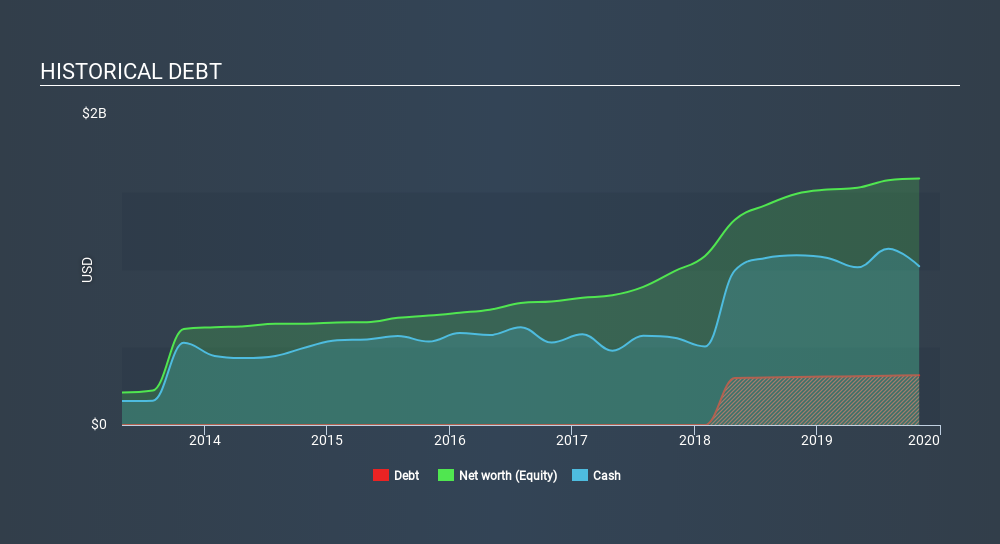
Legendary fund manager Li Lu (who Charlie Munger backed) once said, 'The biggest investment risk is not the volatility of prices, but whether you will suffer a permanent loss of capital. When we think about how risky a company is, we always like to look at its use of debt, since debt overload can lead to ruin. We note that Guidewire Software, Inc. (NYSE:GWRE) does have debt on its balance sheet. But is this debt a concern to shareholders?
What Risk Does Debt Bring?
Debt is a tool to help businesses grow, but if a business is incapable of paying off its lenders, then it exists at their mercy. If things get really bad, the lenders can take control of the business. While that is not too common, we often do see indebted companies permanently diluting shareholders because lenders force them to raise capital at a distressed price. Of course, the upside of debt is that it often represents cheap capital, especially when it replaces dilution in a company with the ability to reinvest at high rates of return. The first step when considering a company's debt levels is to consider its cash and debt together.
See our latest analysis for Guidewire Software
What Is Guidewire Software's Net Debt?
As you can see below, at the end of October 2019, Guidewire Software had US$320.5m of debt, up from US$308.1m a year ago. Click the image for more detail. But it also has US$1.02b in cash to offset that, meaning it has US$700.6m net cash.

A Look At Guidewire Software's Liabilities
We can see from the most recent balance sheet that Guidewire Software had liabilities of US$164.7m falling due within a year, and liabilities of US$448.8m due beyond that. Offsetting these obligations, it had cash of US$1.02b as well as receivables valued at US$139.3m due within 12 months. So it actually has US$546.8m more liquid assets than total liabilities.
This short term liquidity is a sign that Guidewire Software could probably pay off its debt with ease, as its balance sheet is far from stretched. Simply put, the fact that Guidewire Software has more cash than debt is arguably a good indication that it can manage its debt safely. The balance sheet is clearly the area to focus on when you are analysing debt. But ultimately the future profitability of the business will decide if Guidewire Software can strengthen its balance sheet over time. So if you're focused on the future you can check out this free report showing analyst profit forecasts.
Over 12 months, Guidewire Software made a loss at the EBIT level, and saw its revenue drop to US$696m, which is a fall of 4.0%. We would much prefer see growth.
So How Risky Is Guidewire Software?
While Guidewire Software lost money on an earnings before interest and tax (EBIT) level, it actually generated positive free cash flow US$69m. So although it is loss-making, it doesn't seem to have too much near-term balance sheet risk, keeping in mind the net cash. With mediocre revenue growth in the last year, we're don't find the investment opportunity particularly compelling. When analysing debt levels, the balance sheet is the obvious place to start. However, not all investment risk resides within the balance sheet - far from it. Take risks, for example - Guidewire Software has 1 warning sign we think you should be aware of.
If, after all that, you're more interested in a fast growing company with a rock-solid balance sheet, then check out our list of net cash growth stocks without delay.
If you spot an error that warrants correction, please contact the editor at editorial-team@simplywallst.com. This article by Simply Wall St is general in nature. It does not constitute a recommendation to buy or sell any stock, and does not take account of your objectives, or your financial situation. Simply Wall St has no position in the stocks mentioned.
We aim to bring you long-term focused research analysis driven by fundamental data. Note that our analysis may not factor in the latest price-sensitive company announcements or qualitative material. Thank you for reading.
About NYSE:GWRE
Guidewire Software
Provides a platform for property and casualty (P&C) insurers worldwide.
Excellent balance sheet with reasonable growth potential.
Similar Companies
Market Insights
Community Narratives


